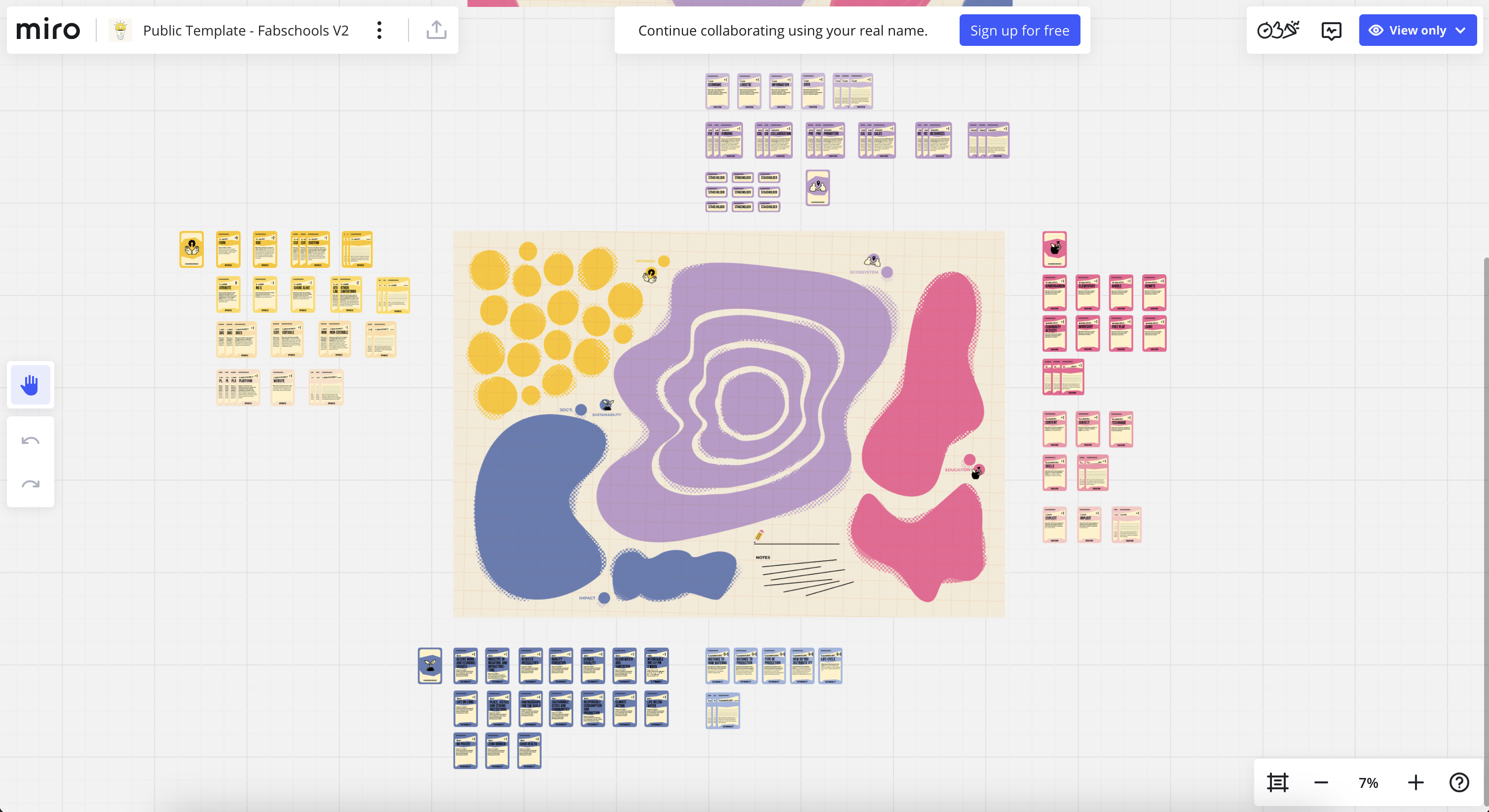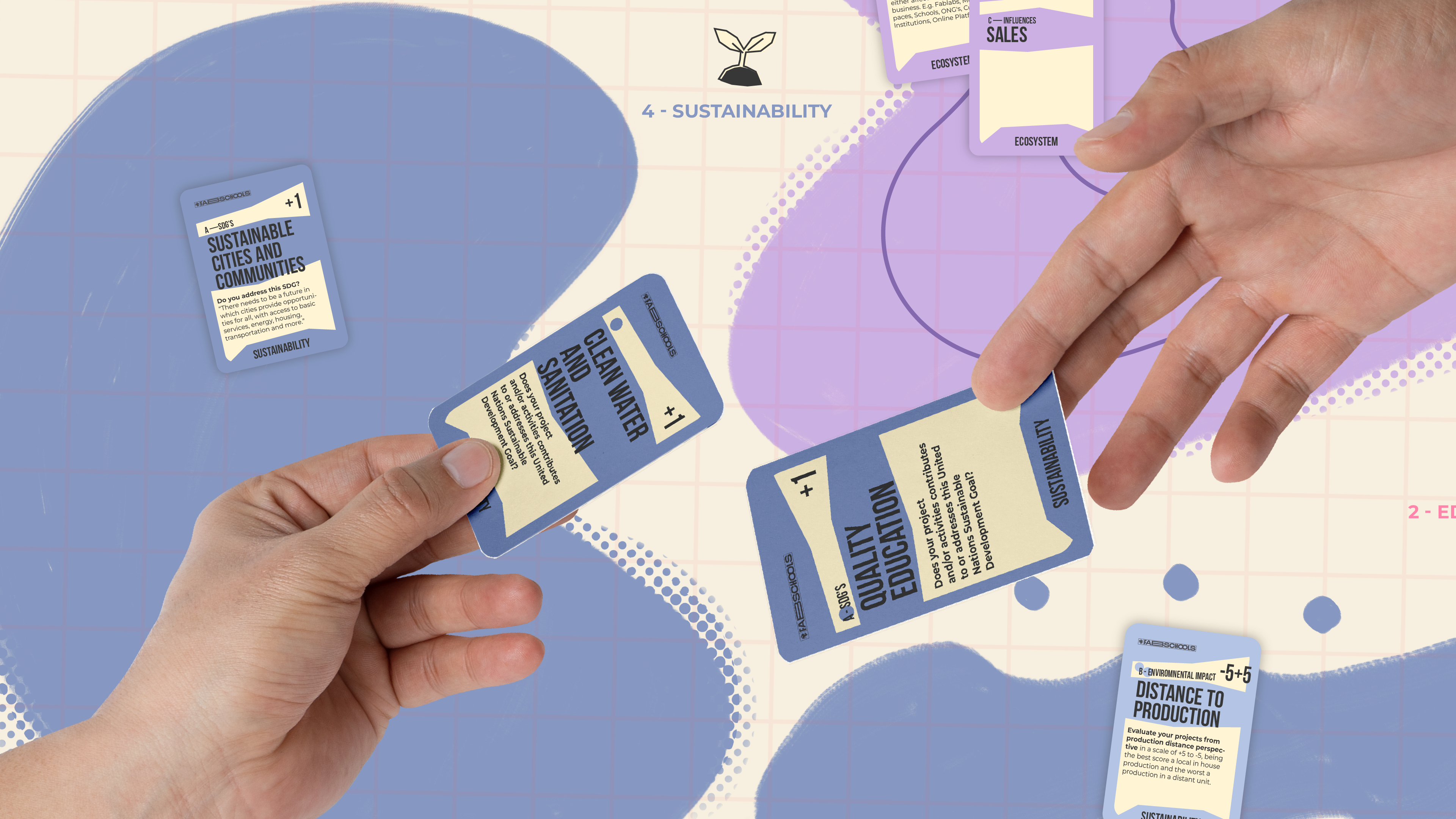Evaluating Sustainability with the Fabschools Distributed Design Game
The Fabschools Distributed Design Game represents a significant step in merging educational design with distributed design principles. Developed by the Fabschools team at the School of Education of the Polytechnic University of Lisbon, this version 1.0 release combines a specialized card deck with a companion game board.
The game serves two primary objectives: fostering collaboration between designers and educators in creating open educational resources for makerspace/fablab environments and assessing projects’ alignment with distributed design values. Through systematic card play and board interaction, teams evaluate and develop their initiatives across four key dimensions.
This post is part two of a series examining the game’s implementation framework. In our previous post, we explored how the openness framework helps teams implement transparent, replicable, and accessible design processes. This second post examines how sustainability assessment complements these openness decisions. Future posts will address stakeholder ecosystem mapping and educational framework integration.
Introduction to the Card System
The digital Miro board template structures sustainability evaluation alongside other dimensions of project development. Teams use this collaborative workspace to place cards, calculate environmental impact scores, and map connections to global sustainability goals. The visual nature of the board helps teams see relationships between sustainability choices and other project aspects.

Sustainability in Distributed Design
The sustainability dimension divides into two complementary approaches: alignment with UN Sustainable Development Goals (SDGs) and environmental impact assessment. This dual structure encourages teams to consider both the broader societal impact of their project and its specific environmental footprint.
SDG Implementation Framework
The SDG cards prompt teams to examine how their project addresses global sustainability goals. Each card (+1) represents one of the seventeen United Nations Sustainable Development Goals, from Quality Education to Responsible Consumption. Teams must provide concrete evidence for each claimed alignment rather than superficial connections.
This examination extends beyond direct contributions. A project might raise awareness about climate action, enable sustainable behaviors through its design, or create frameworks that support multiple SDGs through distributed implementation. For example, an educational kit teaching renewable energy concepts directly addresses SDG 7 (Affordable and Clean Energy) while potentially supporting SDG 4 (Quality Education) and SDG 13 (Climate Action) through its implementation.
Environmental Impact Assessment
While SDGs address broad sustainability goals, the environmental impact cards focus on specific production and distribution choices. Teams evaluate five key metrics on a -5 to +5 scale, encouraging nuanced discussion rather than binary judgments.
Distance to Raw Materials assessment examines source locations and supply chains. Teams discuss whether materials come from distant suppliers (-5) or utilize local resources (+5). This conversation often reveals opportunities for material sourcing improvements that teams might otherwise overlook.
Distance to Production evaluation considers manufacturing approaches. Centralized, distant production scores toward the negative end, while complete local fabrication in educational makerspaces earns positive scores. This metric directly connects to distributed design principles, encouraging teams to consider how production methods align with their broader goals.
Type of Production analysis examines production scale and approach. Mass production of standardized components typically scores lower, while on-demand fabrication of customized elements scores higher. Teams discuss how production methods affect resource usage and adaptation possibilities.
Life-cycle assessment evaluates longevity and reusability. Single-use designs score poorly, while infinitely repairable and adaptable resources score well. This conversation often connects to openness considerations, as more open sharing enables better repair and adaptation.
How Do You Distribute It? scoring focuses on how projects reach users. Digital distribution for local production represents the ideal (+5), while shipping completed products over long distances scores toward the negative end. Teams often discover hybrid approaches through these discussions.
Collaborative Decision-Making
The subjective nature of environmental scoring generates valuable team conversations. Different perspectives lead to the identification of alternative solutions, recognition of hidden impacts, and development of innovative approaches. These discussions matter more than the final numbers themselves.
Through collaborative debate, teams discover supply chain alternatives, production improvements, distribution efficiencies, and lifecycle extensions. The process creates shared understanding and often reveals connections to other dimensions of project development. A distribution improvement might simplify stakeholder relationships, or a material change could enhance educational possibilities.
Integration with Distributed Design Principles
The sustainability framework connects directly with core distributed design benefits. Local manufacturing reduces transportation impacts. Digital distribution minimizes material waste. On-demand production prevents overstock. These connections emerge naturally during gameplay as teams balance environmental scores with openness decisions and stakeholder engagement.
The SDG alignment process reinforces distributed design’s role in sustainable development. Teams discover how local production and open sharing enable broader contributions to global goals. This understanding shapes project evolution across educational, social, and environmental dimensions.
The visual nature of the Miro template helps teams see these relationships, demonstrating how sustainability choices influence overall project implementation. The collaborative nature of SDG assessment and environmental scoring creates deeper understanding of project impact beyond simple metrics.
The next post examines ecosystem mapping, showing how stakeholder relationships shape project development within the distributed design framework.
Access the Fabschools Distributed Design Game template: [Miro Board Link]
